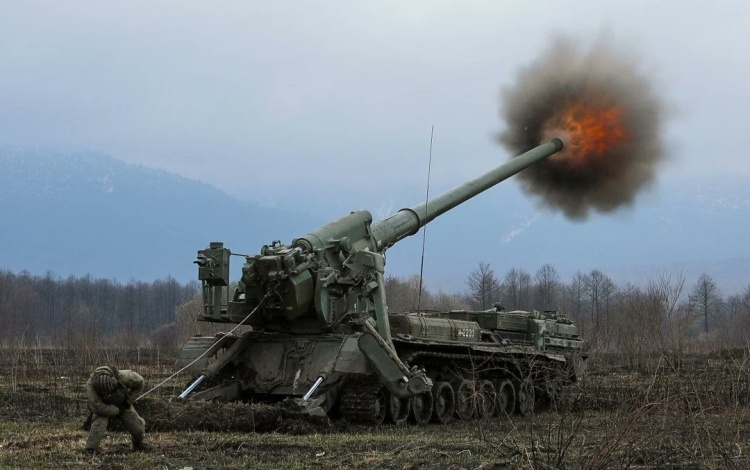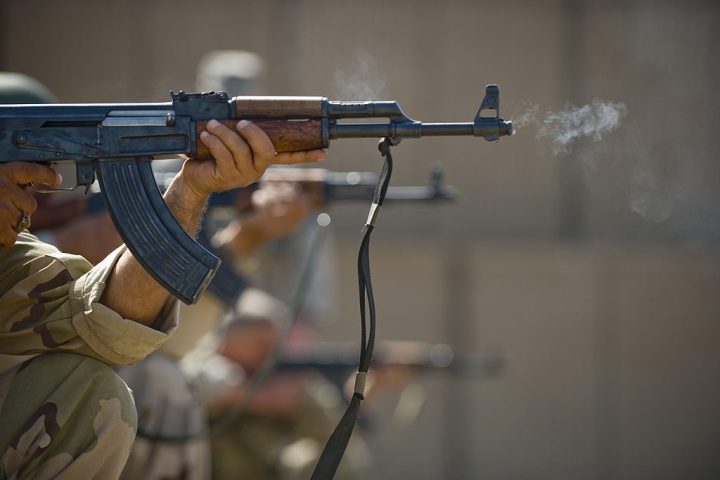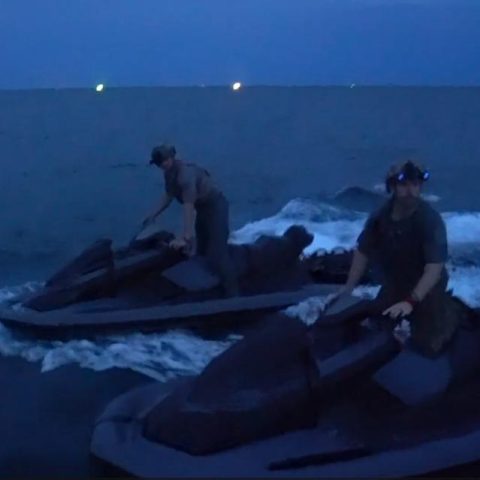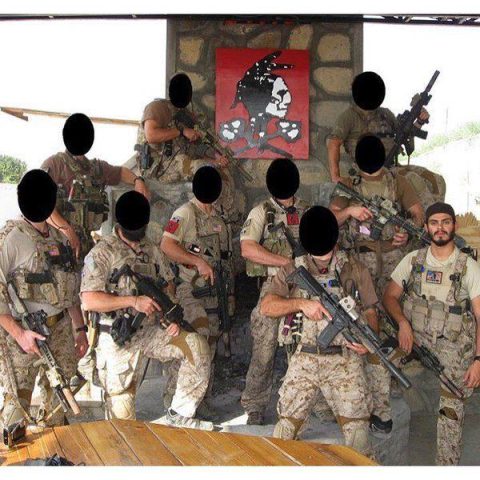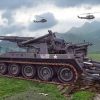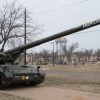The 2S7 Pion, or Malka, is a Soviet-made self-propelled 203 mm gun intended to suppress rear line posts, destroy critical facilities, and as a means of a nuclear attack in a tactical depth of 47 km. It was widely used in the Soviet Union (SSSR) and has been dubbed the “most powerful howitzer in the world.” So far, between 500 and 1,000 units have been built.
Key recognition features
- Fully enclosed cab at far front, well forward of front drive sprockets
- 203 mm cannon in the unprotected mount at far rear, overhangs the front of the vehicle when in traveling lock
- Large spade at the rear with ammunition handling system right
Development
In the 1950s, the first Soviet artillery systems armed with nuclear warheads were the 2B1 and 2A3 self-propelled guns. But these systems were cumbersome and not agile enough to meet the Soviet Army’s requirements.
By the spring of 1967, Soviet Army came up with a preliminary design request for a new heavy-duty self-propelled artillery unit based on the tank “Object 434” and a wooden mockup. The result was fully enclosed, with a conning tower made by the OKB-2 design bureau, but it received negative feedback from the representatives of the Ministry of Defence.
On December 16, 1967, research studies began to determine the shape and the best basic characteristics of the new self-propelled gun. Object 216 was a prototype for a Soviet 203-mm self-propelled gun artillery for the Supreme Command. It was developed at the Leningrad Kirov “Barrikady” plant, and the chief designer of the chassis was N. Popov. GI Sergeev developed the 203 mm 2A44 howitzer.
The final design was approved in July 1970, and in 1973 the tactical and technical requirements were approved. The required gun range was 35 km, and it could fire 110 kg HE rounds, as well as the nuclear 3VB2 D-4M special ammunitions. The “216.sp2” was built from 1973 to 1974, leading to two prototypes, 2S7, sent to the testing grounds at Struga Red. In 1975, the 2S7 was officially adopted by the Soviet Army, and in 1977 supplies of nuclear ammunition were received.
The 203 mm self-propelled gun is designated M1975 by US Army, although its correct Russian designation is SO-203 and GRAU (industrial number) is 2S7. It entered service with the Soviet army in the late 1970s, and it is the world’s largest full-tracked self-propelled gun. Within the Russian Army, it is also known as the Pion (Peony).
The chassis is a new design with a fully enclosed armored cab front, engine to immediate rear, and 203 mm cannon mounted on top at the far end of the hull. No protection for the gun crew from small arms fire, shell splinters, or NBC agents. When in firing position, a large hydraulically operated spade is lowered at the rear for more projectile and charge, load assist device on the right side of chassis. In action, it is accompanied by another vehicle carrying the remainder of the gun crew and ammunition.
The 203 mm artillery has a traverse of 15 degrees left and right with elevation from 0 degrees to +60 degrees. The maximum range firing an unassisted projectile is 37.5 km. While firing a rocked assisted ammunition, a maximum range of 47 km can be achieved.
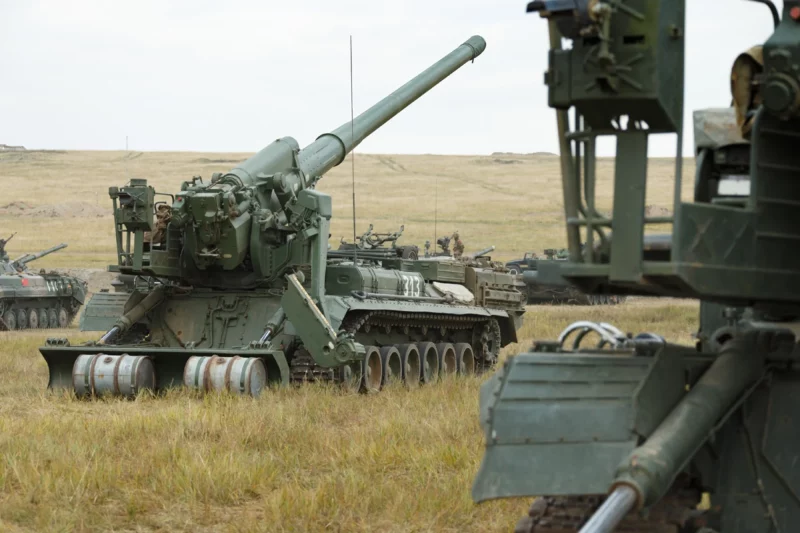
Design
The basic design is based on the T-80 chassis, modified to carry an externally mounted 2A44 203 mm gun. It has hydraulic spades at the rear, used to moderate or stop the recoil when firing. The commander, gunner, and driver/mechanic are seated in the front driver’s compartment, with circular roof hatches and day periscopes in addition to the folding shutters. Just behind the engine is the secondary crew compartment, which the remaining four crew members can access through two circular roof hatches.

Armament
The cannon was derived from an existing heavy gun with a caliber of 203 mm. It can fire a 110 kg projectile to a maximum firing range of 37.5 to 47.5 km and at a maximum rate of fire of 1.5. The gun has – 0 to + 60 degrees elevation and a limited traverse of 30 degrees. It can fire ordinary HE-FRAG ZOF-43 rounds containing 17.8 kg of explosives or rocket-assisted projectiles (103 kg, 13.8 kg of explosives) to reach the 47 km range.
The average maximum muzzle velocity is 960 m/s. Despite the crew being carried by the vehicle, only four of the eight ammunitions round have to be taken separately. This self-propelled gun was intended to fire 1 or 2 rounds before leaving for another firing position even before the first round hits the target, 47 km away. A shoot-and-scoot capability to avoid counter-battery fire.
Protection
Protection for the crew (front compartment) was assured against small arms fire and shell splinters on the frontal arc, but the operating crew, either mounted or on foot, was not. Individual armament comprised several Kalashnikov and a single MANPAD. The front compartment was also provided with an NBC system of the overpressure type, a heater, and night vision equipment. There was also a 24 hp 9R4-6U2 auxiliary power unit. The gun operator was seated at the vehicle’s rear on the left side and given a PG-1M panoramic day telescope plus a K-1 collimator.
Mobility
The V-46-I V-12 liquid-cooled diesel engine is coupled to an eight-speed manual transmission. It is located to the rear of the front driving compartment, while the rear chassis was dedicated to the weapon system. The suspension consists of seven dual rubber-tired road wheels plus six track-return rollers per side. The drive sprocket was at the front and the idler at the rear. Shock absorbers are installed on all but the 4th and 5th roadwheel stations. The deployment procedure involves lowering the chassis and deploying the hydraulic rear recoil spades. The top speed (road) is 50 km/h with about a 600 km range. It can overcome a trench of 2.5 m and a vertical step of 70 cm.
Variants
2S7M Malka, also known as the Pion-M, had the R-173 communications equipment and could carry eight 203 mm projectiles and charges. The rate of fire was increased to 2.5 per minute.
BTM-4 trench digger based on Pion chassis.
In 1997, the engineering trench digger BTM-4M “Tundra” was commissioned. After 1990 the Kirov plant carried out a conversion program from its military technology, and the 2S7 was also turned into civil engineering.
In 1994, the SGK-80 crane appeared, and its modernized version, SGK-80R, came out in 1998. They weigh 65 tons with a lifting capacity of up to 80 tons. The CM-100 was also designed to manage railroad maintenance and rescue operations after disasters.
Operational usage
2S7 Pion is in service with the Czech Republic, Poland, Russia, and Slovakia. Probably there are some units in other former Soviet Republics. It is relatively easy to use, and according to the available information, the well-trained crew can enter the action in 5 to 6 minutes and 3 to 5 minutes to come out of action.
It was first used during the Soviet campaign in Afghanistan. Some of them were seen during the conflict in Georgia in 2008. After the Russian invasion of Ukraine, both sides deployed 2S7M versions.
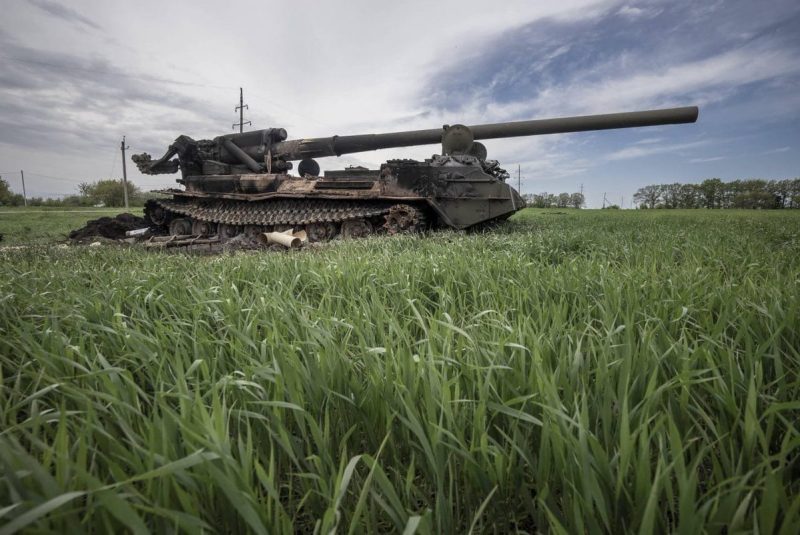
Technical specifications
| Country of origin: | Soviet Union (SSSR) |
| Manufacturer: | Kirov Factory and Titan-Barrikady Plant |
| Crew: | 7 |
| Armament: | 1 x 203.2 mm gun |
| Ammunition: | 4 x 203.2 mm |
| Length gun forwards: | 13.12 m |
| Length hull: | 10.50 m |
| Width: | 3.38 m |
| Height: | 3.00 m |
| Ground clearance: | 0.40 m |
| Weight, combat: | 65,500 kg |
| Weight, unloaded: | 63,500 kg |
| Power-to-weight ratio: | 18.06 hp/tonne |
| Ground pressure: | 0.80 kg/cm2 |
| Engine: | V12 liquid cooled diesel developing 840 hp |
| Maximum road speed: | 50 km/h |
| Maximum road range: | 500 km |
| Fuel capacity: | not available |
| Fording: | 1.2 m |
| Vertical obstacle: | 0.70 m |
| Trench: | 2.6 m |
| Gradient: | 40% |
| Side slope: | 20% |
| Armor: | 10 mm max (estimate) |
| Armor type: | steel |
| NBC system: | Yes |
| Night vision equipment: | Yes (driver) |


